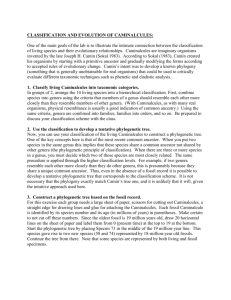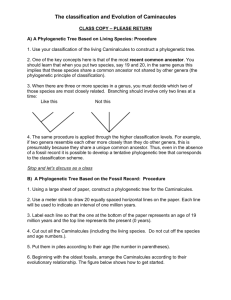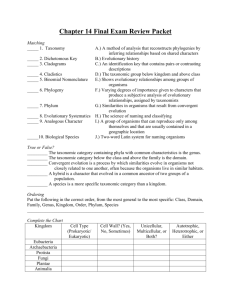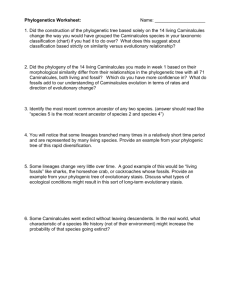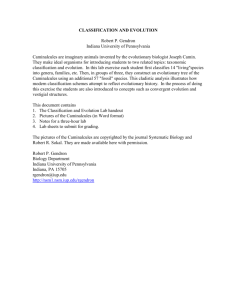Caminalcules: Classification & Evolution Lab Manual
advertisement
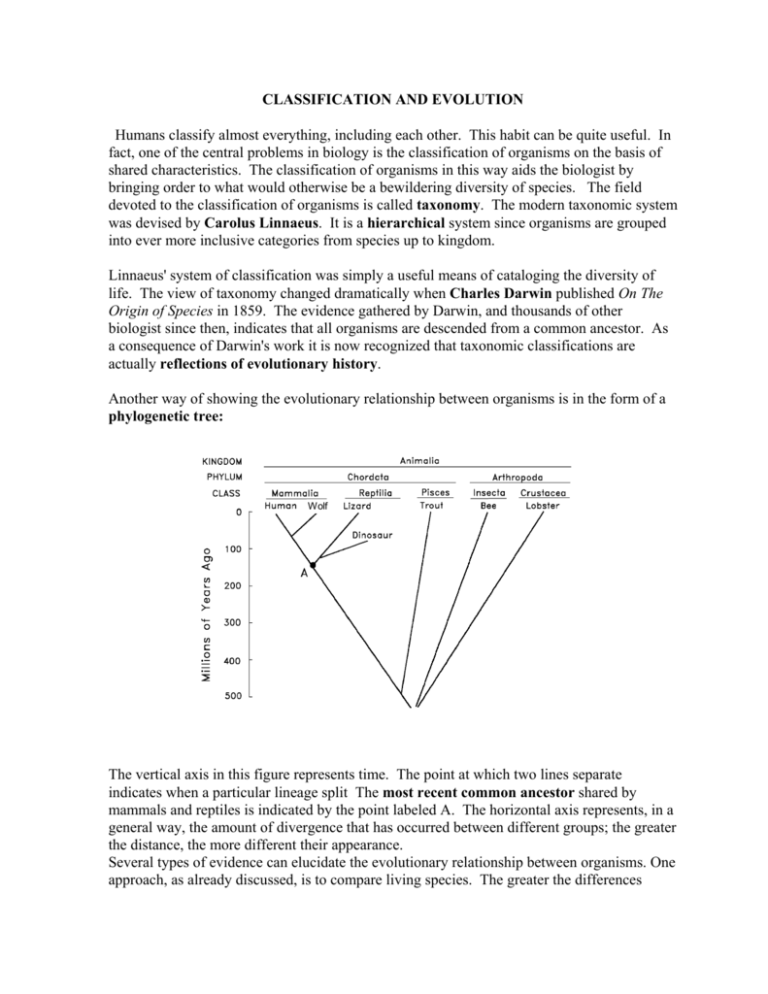
CLASSIFICATION AND EVOLUTION Humans classify almost everything, including each other. This habit can be quite useful. In fact, one of the central problems in biology is the classification of organisms on the basis of shared characteristics. The classification of organisms in this way aids the biologist by bringing order to what would otherwise be a bewildering diversity of species. The field devoted to the classification of organisms is called taxonomy. The modern taxonomic system was devised by Carolus Linnaeus. It is a hierarchical system since organisms are grouped into ever more inclusive categories from species up to kingdom. Linnaeus' system of classification was simply a useful means of cataloging the diversity of life. The view of taxonomy changed dramatically when Charles Darwin published On The Origin of Species in 1859. The evidence gathered by Darwin, and thousands of other biologist since then, indicates that all organisms are descended from a common ancestor. As a consequence of Darwin's work it is now recognized that taxonomic classifications are actually reflections of evolutionary history. Another way of showing the evolutionary relationship between organisms is in the form of a phylogenetic tree: Wolf The vertical axis in this figure represents time. The point at which two lines separate indicates when a particular lineage split The most recent common ancestor shared by mammals and reptiles is indicated by the point labeled A. The horizontal axis represents, in a general way, the amount of divergence that has occurred between different groups; the greater the distance, the more different their appearance. Several types of evidence can elucidate the evolutionary relationship between organisms. One approach, as already discussed, is to compare living species. The greater the differences between them, the longer ago they presumably diverged. There are, however, pitfalls with this approach. The fossil record can also be helpful for constructing phylogenetic trees. The use of fossils is not without its problems, however. The most notable of these is that the fossil record is incomplete. This is more of a problem for some organisms than others. For example, organisms with shells or bony skeletons are more likely to be preserved than those without hard body parts. The Classification and Evolution of Artificial Organisms In this lab you will develop a taxonomic classification and phylogenetic tree for a group of imaginary organisms called Caminalcules. At the end of this lab are pictures of the "living" and "fossil" species that you will use. Take a look at the pictures and note the variety of appendages, shell shape, color pattern, etc. Each species is identified by a number rather than a name. For fossil Caminalcules there is also a number in parentheses indicating the geological age of each specimen in millions of years. Most of the fossil Caminalcules are extinct, but you will notice that a few are still living. The purpose of this lab is to illustrate the principles of classification and some of the processes of evolution (e.g. convergent evolution). We do these exercises with artificial organisms so that you will approach the task with no preconceived notion as to how they should be classified. This means that you will have to deal with problems such as convergent evolution just as a taxonomist would. With real organisms you would probably already have a pretty good idea of how they should be classified and thus miss some of the benefit of the exercise. Exercise 1: The Taxonomic Classification of Living Caminalcules Carefully examine the living species and note the many similarities and differences between them. On a sheet of paper create a hierarchical classification of these species, using the format in Figure 3. Instead of using letters (A, B, ...), as in this example, use the number of each Caminalcule species. Keep in mind that Figure 3 is just a hypothetical example. Your classification may look quite different than this one. GENUS 1 A G PHYLUM CAMINALCULA CLASS 1 ORDER 1 FAMILY 1 FAMILY 2 GENUS 2 GENUS 3 GENUS 4 H D B J L CLASS 2 ORDER 2 ORDER 3 FAMILY 3 FAMILY 3 GENUS 5 GENUS 6 E K C F I Figure 3 The first step in this exercise is to decide which species belong in the same genus. Species within the same genus share characteristics not found in any other genera (plural of genus). Use the same procedure to combine the genera into families. Again, the different genera within a family should be more similar to each other than they are to genera in other families. Families can then be combined into orders, orders into classes and so on. Depending on how you organize the species, you may only get up to the level of order or class. You do not necessarily have to get up to the level of Kingdom or Phylum. Exercise 2. The Comparative Approach to Phylogenetic Analysis A Construct a phylogenetic tree based only on your examination of the living species. This tree should reflect your taxonomic classification. For example, let us say you have put species A and G into the same genus because you think they evolved from a common ancestor (x). Their part of the tree would look like the x diagram on the right. When there are three or more species in a genus you must decide which two of the species share a common ancestor not shared by the other(s). This diagram E K indicates that species E and K are more closely related to each other than either is to C. We hypothesize that E and K have a common ancestor (y) that is not shared y by C. Similarly, two genera that more closely resemble each other than they do z other genera presumably share a common ancestor. Thus, even in the absence of a fossil record it is possible to develop a phylogenetic tree. We can even infer what a common ancestor like y might have looked like. Exercise 3. The Phylogeny of Caminalcules Using a large sheet of paper, construct a phylogenetic tree for the Caminalcules. Use a meter stick to draw 20 equally spaced horizontal line on the paper. Each line will be used to indicate an interval of one million years. Label each line so that the one at the bottom of the paper represents an age of 19 million years and the top line represents the present (0 years). Cut out all the Caminalcules (including the living species). Put them in piles according to their age (the number in parentheses). Beginning with the oldest fossils, arrange the Caminalcules according to their evolutionary relationship. Figure 4 shows how to get started. Figure 4 Millions of Years Ago 17 18 19 ? ? ? 7 5 7 G C Hints, Suggestions and Warnings a. Draw lines faintly in pencil to indicate the path of evolution. Only after your instructor has checked your tree should you glue the figures in place and darken the lines. b. Branching should involve only two lines at a time: c. d. e. f. Like this Not this Some living forms are also found in the fossil record. There are gaps in the fossil record for some lineages. Also, some species went extinct without leaving any descendants (remember the dinosaurs). The Caminalcules were numbered at random; the numbers provide no clues to evolutionary relationships. There is only one correct phylogenetic tree in this exercise. Problems 1. You will notice that some lineages (e.g. the descendants of species 56) branched many times and are represented by many living species. Discuss the ecological conditions that you think might result in the rapid diversification of some lineages (A real world example would be the diversification of the mammals at the beginning of the Cenozoic, right after the dinosaurs went extinct.) 2. Some lineages (e.g. the descendants of species 58) changed very little over time. A good example of this would be “living fossils” like the horseshoe crab or cockroach. Again, discuss the ecological conditions that might result in this sort of long-term evolutionary stasis. 3. Some Caminalcules went extinct without leaving descendents. In the real world, what factors might increase or decrease the probability of a species going extinct? 4. Find two additional examples of convergent evolution among the Caminalcules. This means finding cases where two or more species have a similar characteristic that evolved independently in each lineage. The wings of bats, birds and bees are an example of convergence since the three groups did not inherit the characteristic from their common ancestor. Write your answers in complete sentences (e.g. “Species x and y both have ____ but their most recent common ancestor, z, did not”). 5. List two additional real-world examples of convergent evolution (ones that we have not already talked about in class) and discuss what might have caused the convergence. 6. Describe two examples of vestigial structures that you can find among the Caminalcules. These are structures that have been reduced to the point that they are virtually useless. Ear muscles and the tail bones are examples of vestigial structures in our own species. 7. Explain how vestigial structures provide clues about a species’ evolutionary past. Illustrate your argument with vestigial structures found in humans or other real species. Ignore the following: 9, 19, 20, 28, 30, 31, 33, 36, 37, 38, 40, 48, 50, 55, 57, 61, 67, and 70 LIVING CAMINALCULES FOSSIL CAMINALCULES (numbers in parentheses indicate age in millions of years) FOSSILS (continued) Classification & Evolution Lab Instructor notes meter sticks scissors white glue Paper 1 per group 1 per student 1-2 per table 1 large sheet (approximately 2.25’ x 3’) per group 1. Run through the first two exercises with the class as a whole, using an overhead projector and transparent cutouts of the living Caminalcules. You can ask the students questions and guide their responses. This not only speeds up the lab, it also minimizes confusion because you can insure that the students are starting the lab on the right foot. 2. Have the students do the first two exercises on their own before they come to class (see below) then briefly go over the results at the beginning of the lab. After completing Exercise 2 students should better understand that, a. the taxonomic classification reflects evolutionary history, b. species within a taxonomic group (e.g. within a genus) share a common ancestor not shared by other species, and c. species should be grouped together on the basis of more than one shared characteristic. With respect to this last point, many students conclude that, because they both have claws, species 3 and 12 must be more closely related to each other than to any other species. You may have to draw their attention to other characteristics (body shape, elbows, hind feet, etc.) A copy of the "correct" phylogenetic tree, as devised by Camin is available but should not be shown to the students until after they have done there own. The important thing is that their tree is internally consistent and that they understand the evolutionary concepts involved in the exercise. Example Lab Assignment: The lab next week on the classification and evolution of organisms involves three exercises. You will do exercise 1and 2 before coming to lab. Make two copies of your work and turn in one copy at the beginning of the lab. You will keep the second copy to use during the lab as you do the third exercise.

